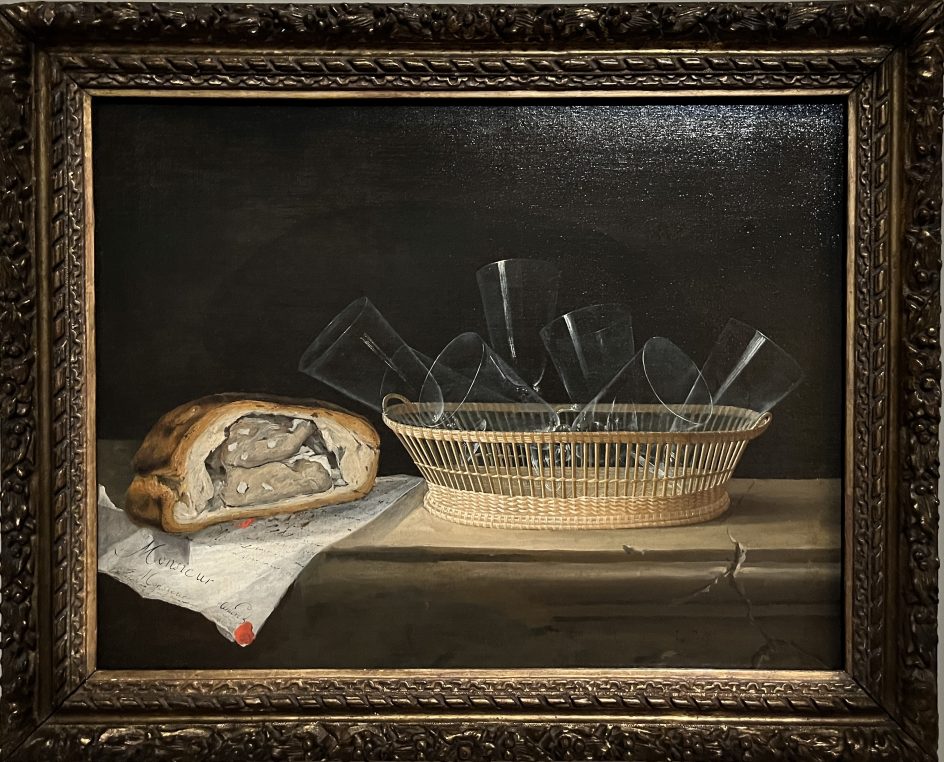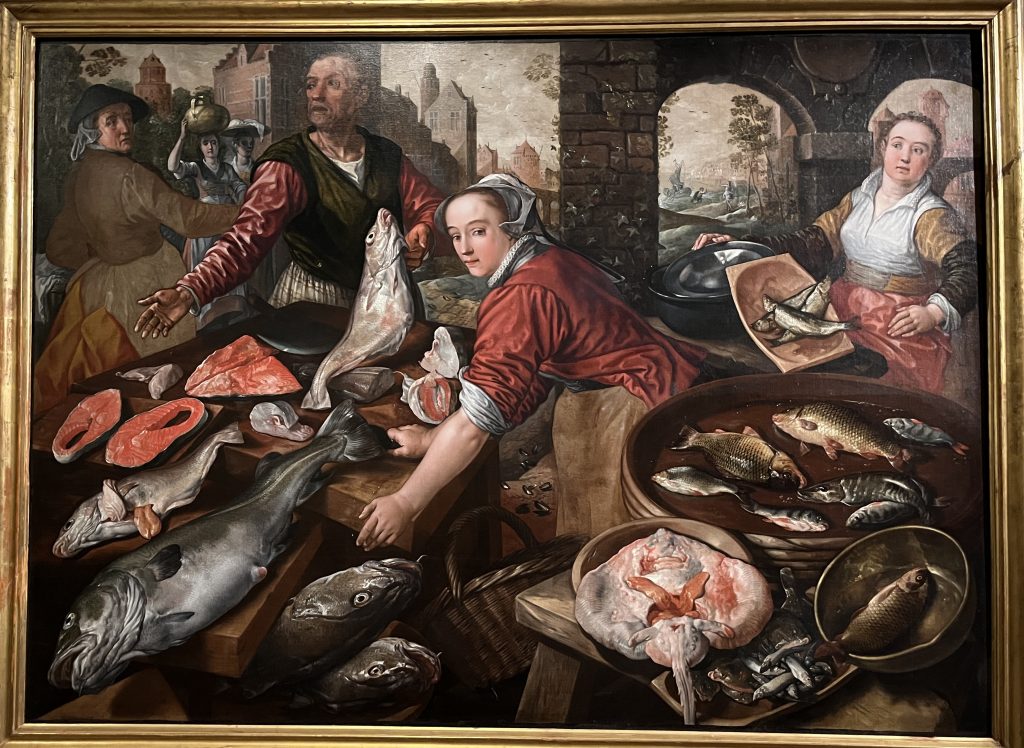
Sébastien Stoskopff, “Basket with glasses and pâté”, ca 1630-1640, Strasbourg, musée de l’Oeuvre Notre-Dame, on a long term loan at Musée des Beaux Arts
The first time I went to see “Les Choses” at the Louvre, I found the first room with Christian Boltanski’s picture of “François C’ clothes”, a large Spoerri installation and a video, really irritating. Why bring contemporary art to the Louvre, just for the sake of it? I calmed down a little bit in the second room which is stunning with four mosaics of a skeleton, a “Memento Mori” and a still life of fish and birds, found in Pompei in the first century bc. I then ran through the show grasping moments of pleasure from time to time and not understanding the point of it. The numerous explanations are too abstract for me and I don’t like to have to read to understand a painting. When I returned a few days later I was struck by the strength of some works like Peter Aertsen‘s “Dutch farmer” or Joachim Beuckelaer‘s “Kitchen scene with Jesus in the House of Martha and Mary in the background” and really enjoyed myself. The exhibit is too intellectual for me in its theme (I hate the title Choses which is as ugly in French as it is in English), even though it treats of daily items in still lives. It has now become the favorite topic of conversation at chic dinner parties (recently at château de Courson Bel Canto evening) and contradictory arguments are fiercely exchanged.
“The depicting of things reached the heights of realism with the trompe l’oeil technique. In his Natural History (77 AD) Pliny the Elder tells the story of a painter called Peiraikos who was famous for his depictions of ordinary things. Although he painted humble objects, his little paintings sold at far higher prices than large paintings …” This is how Laurence Bertrand Dorléac, the curator of the show, introduces her exhibition insisting on the dialogue between works of today and those from the past. How do artists render reality? What is “live” and “still life”? Animals, humans, vegetable, wealth, poverty, markets, money. How does one select daily objects and masterpieces?
It seems that it was very hard for her to make a selection and to focus on a theme. There are extraordinary paintings from the 16 th century as well as from the 20 th century (I love Séraphine de Senlis’ “Flowers” for example) but it is hard to understand Rembrandt’s “Ecorché” hanging in a superb semicircular black room and its connection to Andres Serrano’s “Cabeza de Vaca” except that both animals are dead. “Dead animals… have served to remind us of the fragility of the human condition” says the cartel, ” Such images have the power to shock… “They seem to stare at us accusingly- they have their eye on us”.

Bernard Buffet, Still Life with the head of a mutton (after Goya), 1952, Basel, Stiftung im Obersteg
But the didactic way of showing Arcimboldo’s two masterpieces from the Louvre along a video by Czech artist Jan Svankmajer does not appeal to me. There is a wonderful “Live still life” (nature morte vivante) by Salvador Dali, a Miquel Barceló “Sword wish in grisaille” (more grisailles are hanging in Pantin at Thaddaeus Ropac’s), a beautiful Bernard Buffet with a mutton head based on Goya. Martial Raysse, Giorgio Morandi, Foujita, Odilon Redon all have wonderful still lives to show but what connects them?

Italy, Faenza or Pesaro, Hand heater in the shape of a closed book, 1490-1510, faience and metal, Paris Musée du Louvre
I loved the hand heater, in the shape of a book in ceramics in which you introduced hot water. It was made at the time when Livres d’heures were extremely popular and this is typically an intimate piece which leads us in the interior of a house.
There are fabulous paintings dedicated to food, markets, cooks in their kitchen in Holland and Germany in the 16 th century and a copper ceremonial bell made in Nigeria in the 16 th -17 th century. A magnificent object lent by Musée du quai Branly but again what is the connection? The section devoted to money is fun with the “Tax Collector” by Marinus van Reymerswale, Hieronymus Franker’s “Wealth of the miser and his death” and a contemporary piece by Esther Ferrer “Europortrait, 2002” a self-portrait of the artist vomiting euros.
The curator is an art historian and teacher sat Sciences Pô. I wonder if she did not want to do too well and included too many masterpieces which are not really working together? You will have to make your own mind about the show, “Les Choses”, before January 23 at the Louvre.
Share this Post





6 Comments on “Les Choses, “Things”, at the Louvre”
Chère Laure,
Je n’ai pas encore vu l’exposition, mais très intrigué par ce qu’on m’en dit, Judith en particulier qui a adoré !
Tu sais combien comme toi: ” I don’t like to have to read to understand a painting.”
On en parlera quand je l’aurai vu. On rentre de Montech ce soir et je vais y courir.
Bonne journée, Jean-Hubert
I feel like I’ve run through the exhibit with you and peeked in at the dinner party in Courson! I’ve never thought of chose as an ugly word but I see your point when it reduces a completely dazzling collection like this to *things. The skeleton carrying wine jugs and the little hand-warmer book seem to escape the curator’s didactic purpose. As always, thank you for a magical outing!
Bonjour,
J aimerais recevoir vos « news letter »du mardi.
Sincèrement
Marie Rossi
I guess the show is trying to force the viewer to consider the relationship between everyday objects i.e. “things” and art?
I was delighted by many of the works in the exhibition but as you say, it is hard to work out exactly what is supposed to stitch them all together.
Perhaps the curator had an initial insight and sort of lost her way : resorting to a title such as ‘Things’ does suggest a certain lack of purposefulness and clarity as to what it is all about…
I totally agree with your view on “Choses”.
I found the exhibition too sophisticated therefore not fluid. Something is missing. I finished the tour and I didn’t feel fulfilled.